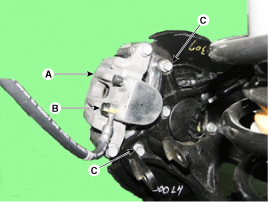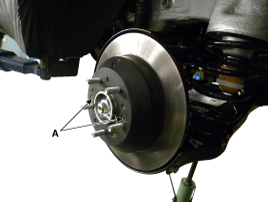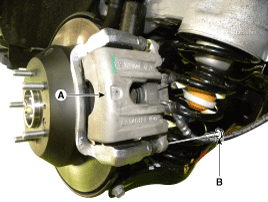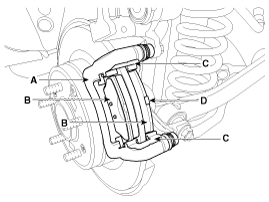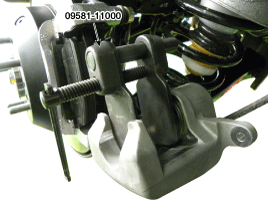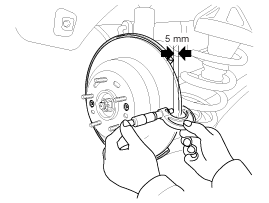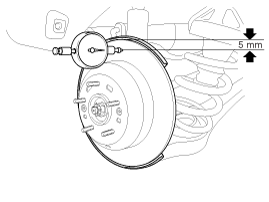 Hyundai Santa Fe: Rear Disc Brake. Repair procedures
Hyundai Santa Fe: Rear Disc Brake. Repair procedures
Removal
| 1. |
Remove the rear wheel & tire.
|
| 2. |
Loosen the hose eyebolt (B) and caliper mounting bolts (C), then
remove the rear caliper assembly (A).
|
| 3. |
Remove the rear brake disc by loosening the screws (A).
|
Replacement
| 1. |
Remove the rear wheel & tire.
|
| 2. |
Loosen the guide rod bolt (B) and pivot the caliper (A) up out
of the way.
|
| 3. |
Replace pad shim (D), pad retainers (C) and brake pads (B) in
the caliper carrier (A).
|
| 4. |
Use a SST (09581-11000) when installing the brake caliper assembly.
|
| 5. |
Place the caliper body (A) on the caliper carrier and tighten
the guide rod bolts (B).
|
| 6. |
Install the rear wheel & tire.
|
Inspection
| 1. |
Check the brake pads for wear and fade.
|
| 2. |
Check the brake disc for damage and cracks.
|
| 3. |
Remove all rust and contamination from the surface, and measure
the disc thickness at 8 points, at least, of same distance (5mm) from
the brake disc outer circle.
|
| 4. |
If wear exceeds the limit, replace the discs and pad assembly
left and right of the vehicle.
|
| 1. |
Check the pad wear. Measure the pad thickness and replace it,
if it is less than the specified value.
|
| 2. |
Check that grease is applied, to sliding contact points and the
pad and backing metal for damage.
|
| 1. |
Place a dial gauge about 5mm (0.2 in.) from the outer circumference
of the brake disc, and measure the runout of the disc.
|
| 2. |
If the runout of the brake disc exceeds the limit specification,
replace the disc, and then measure the runout again.
|
| 3. |
If the runout exceeds the limit specification, install the brake
disc after turning it 180° and then check the runout of the brake disc
again.
|
| 4. |
If the runout cannot be corrected by changing the position of
the brake disc, replace the brake disc.
|
Installation
| 1. |
Installation is the reverse of removal.
|
| 2. |
Use a SST (09581-11000) when installing the brake caliper assembly.
|
| 3. |
After installation, bleed the
|
 Rear Disc Brake. Components and Components Location
Rear Disc Brake. Components and Components Location
Components 1. Guide rod bolt 2. Bleed screw 3. Caliper carrier 4. Caliper body 5. Inner pad shim 6. Brake pad 7. Pad retainer ...
See also:
Front Seat Shield Inner Cover. Repair procedures
Replacement • Put on gloves to protect your hands. • When prying with a flat-tip screwdriver, wrap it with protective tape, and apply protective tape around the related parts, to prevent damage. • ...
Repair procedures
Teaching Procedures 1. Key Teaching Procedure Key teaching must be done after replacing a defective PCM(ECM) or when providing additional keys to the vehicle owner. The procedure starts with a PCM(ECM) ...
Seat Heater (Air Ventilation). Repair
procedures
Inspection Front Seat 1. Check for continuity and measure the resistance between terminals. No. Description No. Description 1 Heater cushion + 4 Heater back + 2 NTC + 5 - 3 Ground 6 NTC - Standard value ...

